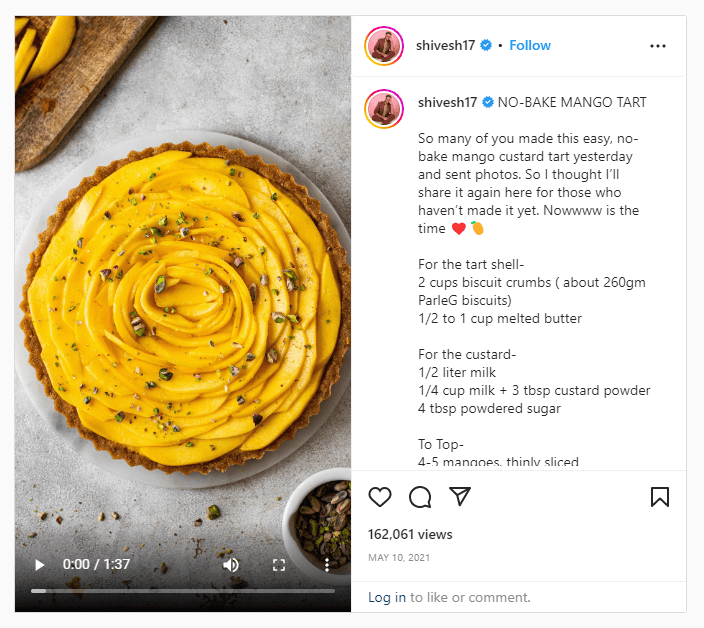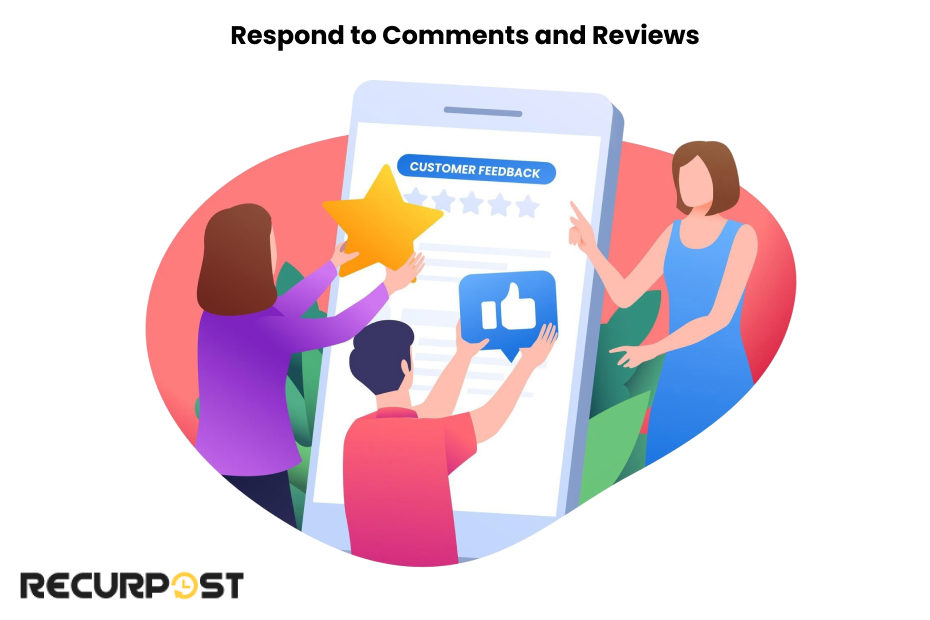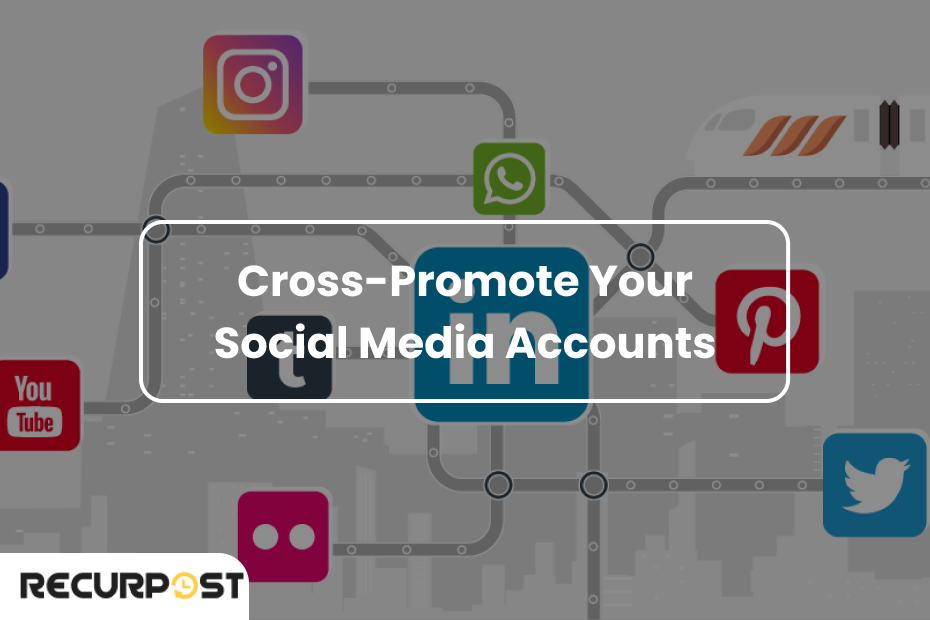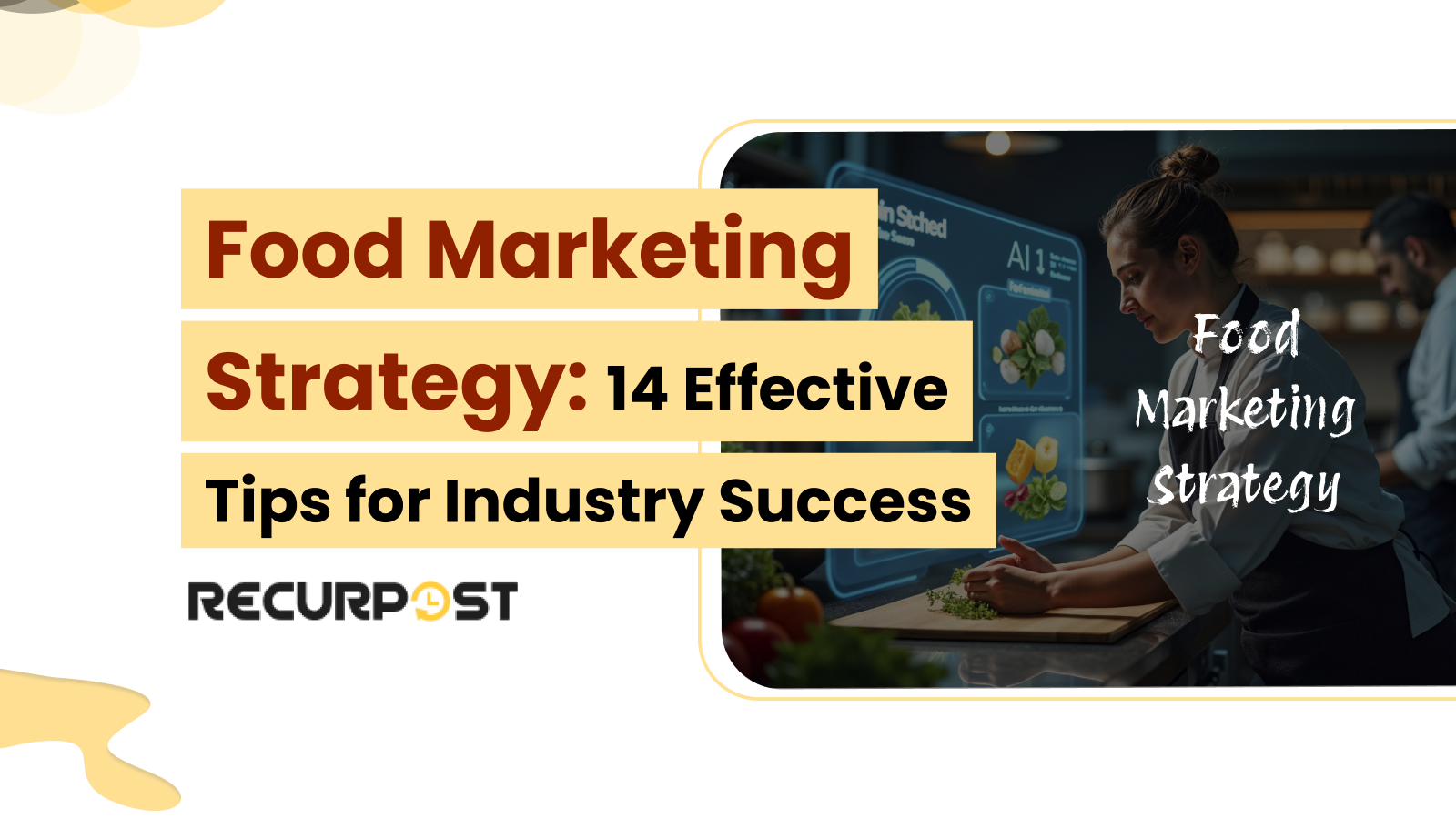Do you run a food company struggling with sales growth? Perhaps you plan to start a food-related business and need marketing strategies that influence consumer behavior.
You might wonder how to create a social media strategy for your food business or how to use social media to promote your brand and increase engagement. Social media benefits food businesses by driving trends, boosting brand loyalty, and turning everyday meals into viral moments.
In this blog, we will cover the basics of food marketing and the effective strategies food businesses use to succeed, giving you the information you need to become the next tycoon in the food industry.
What is a food marketing Strategy?
Food marketing strategy encompasses how companies promote products to consumers through interconnected concepts that drive purchasing decisions.
Food Marketing Strategy Examples:
Food marketing strategies include influencer partnerships, creative packaging, seasonal promotions, and loyalty programs. Social media marketing connects food brands with audiences through storytelling and visuals, driving awareness and repeat purchases.
Food Marketing and Packaging
When launching new food products, companies design packaging that captures attention through strategic colors, graphics, and messaging that communicates product benefits.
Effective packaging can significantly influence consumer purchasing habits by making the product more appealing and easier to recognize.
For example, if a company is selling a snack food, they might use bright colors like red and yellow to make it look more appetizing. On the other hand, if they are selling an organic product, they might use more natural and earthy colors to show that the product is natural and healthy.
Overall, food marketing is all about figuring out what consumers want and how to communicate the benefits of a product in a way that will make people want to buy it.
Food Marketing Trends:
Food marketing evolved from local neighborhood purchasing in the late 1800s to digital marketing approaches that build loyalty through emotional connections with customers, creating family-oriented ads that establish trust.
Popular food trends like organic, vegetarian, and gluten-free can influence what a food product becomes. These trends can also impact the design of food packaging.
Some food companies even use their brand’s strength to launch new products that aren’t part of their regular lineup. For example, Heinz started with pickles, but now sells ketchup, mustard, mayonnaise, salad dressing, and more.
Importance of social networking in marketing
Food Marketing & Messaging:
The way companies advertise their products plays a big role in branding. For example, Smucker’s jelly uses a light-hearted approach in their commercials and emphasizes that they are a family-run business that cares about their product. This makes them a premium brand that can charge higher prices.
Company advertising methods shape branding. Smucker’s jelly uses a light-hearted approach in commercials and emphasizes its family-run business values, positioning them as a premium brand that commands higher prices.
Businesses need a target audience and know where they stand in the market. By understanding their customers’ needs and preferences, they can create effective marketing strategies that will help them succeed.
Social media marketing business plan
Food and Beverage Marketing Trends
Current food beverage marketing trends include sustainability messaging, short-form videos, and AI-powered personalization driving consumer engagement across digital platforms. Instagram Reels and TikTok reshape food discovery, requiring businesses to refine strategies based on trends, analytics, and customer feedback.
Marketing Strategy for Small Food Business
Marketing strategies for small food businesses work best when focusing on community-building, limited-time offers, and storytelling. Small food brands create high-impact content with minimal budget through social media. Behind-the-scenes videos and recipe posts build trust and engagement quickly as part of a consistent social media strategy.
How to use social media for a small business?
Social Media Marketing in the Food Industry
Social media impacts food businesses across the industry. While restaurants often struggle with website maintenance, effective marketing requires digital campaigns that many establishments successfully execute in the food sector.
Social media revolutionizes interactions between people and businesses, making a strong online presence and food content essential for restaurants.
Over 80% of restaurant owners use or plan to use social media as a marketing tool. Food businesses focus on creating viral campaigns and visually appealing posts for social media content.
Brands engage with consumers directly through digital platforms, creating effective marketing and personal connections.
Restaurant owners who adopt social media establish positive public reputations in weeks rather than months or years.
Instagram exemplifies this trend, with 30 percent of millennial diners avoiding restaurants with poor Instagram presence. As restaurant owners become more tech-savvy, establishing a distinct online brand becomes critical.
Using an up-to-date social media account for your food business can give you the following benefits:
- Allows your restaurant to be found on the internet.
- It allows you to share your meals and recipes on the internet visually.
- It enhances your restaurant’s professionalism and validity.
Small restaurants typically find Instagram more effective than Facebook, though Facebook pages enable Instagram advertising. Create accounts on both platforms and use QR codes to direct customers to your social media profiles for increased engagement.
Food Advertising Strategies Beyond Social Media
While social media forms the backbone of modern food marketing, successful food businesses employ multi-channel approaches beyond these platforms to maximize visibility and drive sales.
Traditional and Digital Advertising Mix
Food businesses see the best results when combining traditional advertising methods with digital strategies:
- Print advertising: Food-focused magazines, local newspapers, and direct mail flyers with appetizing visuals and special offers
- Outdoor advertising: Strategically placed billboards near high-traffic areas with simple, hunger-inducing imagery
- Television and radio: Short, memorable commercials highlighting signature dishes or unique selling points
- Digital display ads: Targeted banner and display advertisements on food-related websites and apps
- Search engine marketing: Paid search campaigns targeting food-related keywords to capture high-intent customers
Food Advertising Psychology
Effective food advertising taps into specific psychological triggers:
- Color psychology: Using red and yellow to stimulate appetite and attention
- Scarcity marketing: Creating limited-time offers to drive immediate action
- Social proof: Featuring customer testimonials and reviews prominently in advertisements
- Sensory language: Using descriptive, sensory-rich words that evoke taste, smell, and texture
- Lifestyle association: Connecting food products with aspirational lifestyles or values
Food advertising strategies must align with your overall brand positioning while adapting to current market trends and consumer preferences. The most successful campaigns maintain consistency across all advertising channels while tailoring messages to each platform’s unique strengths.
How the Food Industry Uses Social Media Marketing?
Food businesses engage customers through Facebook, Instagram, TikTok, and Twitter by:
- Post high-quality images of food items.
- Menus can be posted seasonally, daily, or weekly.
- Showcase customer-generated content.
- Customers must be communicated with.
- Recipes should be shared.
- Show us photos and videos from behind the scenes.
- Chefs, waitresses, bartenders, and other personnel should be highlighted.
- Any changes in hours or additional information should be mentioned on social media platforms.
- Respond to customer inquiries promptly to build trust and satisfaction.
Food company owners and beverage managers should maintain active social media presence despite demanding schedules, regularly sharing company information and cuisine highlights.
You can even use Facebook for Restaurants and several other hot social media platforms to market your food industry.
A social media scheduler transforms food business marketing. Create an editorial calendar using RecurPost to schedule Facebook posts in advance, keeping social profiles active through bulk scheduling.
Comprehensive Digital Marketing for Food Businesses
Successful food businesses implement comprehensive digital marketing strategies beyond social platforms. This holistic approach maximizes visibility and engagement across the digital landscape.
Website Optimization for Food Businesses
Your website serves as your digital storefront and should:
- Feature professional food photography with proper lighting and styling
- Include an easy-to-navigate menu with clear descriptions and prices
- Offer seamless online ordering or reservation capabilities
- Incorporate customer reviews and testimonials
- Optimize for local SEO with location-specific keywords
- Provide mobile-friendly design for on-the-go customers
Email Marketing for Food Businesses
Email remains one of the most effective digital marketing channels for food businesses:
- Send personalized birthday offers and loyalty rewards
- Create appetite-inducing newsletters featuring new menu items
- Distribute exclusive recipes or cooking tips to subscribers
- Announce special events, holiday menus, or limited-time offers
- Segment your audience to deliver targeted promotions based on past orders
Search Engine Optimization for Food Businesses
Appearing in relevant searches is essential for food business discovery:
- Research and target food-related keywords with local intent
- Create location-specific landing pages for multi-location businesses
- Optimize Google My Business listing with current hours, photos, and menu
- Build backlinks from food bloggers, local publications, and industry directories
- Create recipe content optimized for featured snippets and voice search
Food Delivery App Marketing
With the rise of food delivery, optimizing your presence on these platforms is crucial:
- Create compelling listings with professional food photography
- Offer app-exclusive promotions to drive initial orders
- Encourage reviews from satisfied customers
- Analyze performance data to optimize menu offerings
- Consider packaging inserts to drive direct orders for future purchases
Integrating these digital marketing strategies with your social media efforts creates a cohesive online presence that attracts and retains customers throughout their digital journey.
Content Marketing Strategies for Food Businesses
Content marketing builds brand authority, engages customers, and drives sales for food businesses without relying solely on promotional messaging. Valuable, relevant content attracts and retains a clearly defined audience.
Types of Content for Food Businesses
Effective content marketing for food businesses can take many forms:
- Recipe content: Shareable recipes featuring your products or signature dishes
- How-to guides: Cooking techniques, food preparation tips, or ingredient selection advice
- Behind-the-scenes content: Stories about your suppliers, staff, or production processes
- Educational content: Nutritional information, food pairing suggestions, or sustainability practices
- Seasonal content: Holiday meal ideas, seasonal ingredient spotlights, or special occasion guides
Content Distribution Channels
Distribute your food-related content across multiple platforms:
- Blog: Maintain a regularly updated blog on your website
- Email newsletters: Send content directly to subscribers’ inboxes
- Social media: Adapt content for different social platforms
- Video platforms: Create cooking demonstrations, taste tests, or chef interviews
- Podcasts: Discuss food trends, interview industry experts, or share food stories
Content Marketing Success Metrics
Measure the effectiveness of your food content marketing:
- Engagement metrics: Comments, shares, and time spent with content
- Lead generation: Email sign-ups, content downloads, or coupon redemptions
- Sales impact: Conversion rates from content to purchase
- SEO benefits: Organic traffic growth and search ranking improvements
- Brand sentiment: Changes in customer perception and brand affinity
Content Calendar for Food Businesses
Organize your content creation around these key themes:
- Seasonal ingredients and dishes: Highlight what’s fresh and timely
- Holidays and special occasions: Create content for major food-centric events
- Product spotlights: Feature new or signature items in your content
- Customer stories: Share testimonials and user-generated content
- Industry trends: Provide your perspective on emerging food trends
Content marketing for food businesses works best when it provides genuine value to your audience while subtly reinforcing your brand positioning. Focus on solving problems, answering questions, or entertaining your audience rather than overtly selling your products.
How Food Marketing Shapes Eating Habits Nationwide?
Food marketing surrounds consumers with shifting messages that influence eating choices and behavior in various ways.
Marketing strategies aligned with consumer preferences encourage healthier eating choices and promote specific food trends.
It is intended to:
- Create food trends that urge you to:
- Purchase specific foods or beverages.
- Purchase food to receive promotional goods such as
- loyalty points.
- Coupons for future food purchases.
- Movie tickets or sports event tickets.
- They connect certain meals or brands with a certain way of life.
- Develop brand loyalty so that you will continue to buy from a specific store or products with a specific brand name.
The major question now is: What kind of social media strategy for the food business can assist you in increasing client engagement? Let’s see what the following recommendations and suggestions reveal.
Tips for social media strategy for a food business!
Even mouth-watering cuisines fail without customer traffic, making a social media presence essential for successful food marketing.
An effective social media strategy increases restaurant awareness and drives visits. Develop your social media presence because:
- 63% of restaurants already use social marketing
- 51% of consumers learn about new food joints through social media
- 37% of internet users go to social media to research brands and their products before making a purchase.
There is no doubt in the fact that your potential customers are spending a lot of time on social media. The following tips will help you in marketing your food on social media and get your restaurant in front of people’s eyes.
14 tips to use social media for food marketing in 2025
1. Choose Social Media Platforms That Matter

Food marketing performs best on Facebook, Instagram, and Twitter.
On Facebook, 59% of users search for restaurants. People prefer to engage with restaurants on Instagram. And Twitter is the social media site where people prefer to leave feedback and ask queries.
While setting up your social media accounts, make sure you complete your profiles and provide all the details possible. When people land on your social account, they should at least get to know your location, business hours, contact number, and a link to your website.
2. Plan Your Content For Food Marketing
Content determines social media success. Creating profiles alone won’t attract customers. Implement a monthly content calendar with images, videos, and written content for consistent updates and engagement.
3. Optimize Your Online Presence

Create a responsive website for findability across search channels. Users clicking social media links should land on responsive pages with updated information.
Link directly to ordering, menu, and reservation pages rather than homepages. Without a website, create and fully complete your Google My Business listing to manage your presence across Google search results and maps, boosting local search visibility and attracting nearby customers. Food blogging is also a great way to build trust amongst your community.
4. Create High-Quality Images And Videos

Successful food marketing on social media evokes the desire to try dishes. With 93% of Instagram users reporting that product images influence purchasing decisions, appetizing pictures and videos become essential.
Your potential customers must be tempted and swayed to visit your restaurant or order online by seeing the images that you post on social media. Images and videos should also be a part of your content plan.
In fact, types of marketing such as video marketing generate twice the engagement as compared to images and text. Social Media For Photographers plays a major role in helping professionals showcase their skills. Hiring a professional photographer to shoot images and videos of your dishes and the interior is an investment you need to consider.
5. Post At The Right Time

Timing determines social media post effectiveness. Posting breakfast dish images when audiences visit bars or sleep wastes engagement opportunities.
Also, you need to post at times when your target audience and followers are the most active on social media. All the platforms provide their own analytics, which you can use to find out the most active times.
6. Run Contests And Giveaways

Contests and giveaways build engagement on social media profiles and spread restaurant awareness. Select prizes such as free meals, gift cards, or event tickets.
The way of letting people enter the giveaway can include:
- Ask people to comment on your giveaway post and tag their friends.
- Ask people to share one of your posts on their social media accounts.
- Gain more followers and engagement by asking people to like your post and follow your account.
- Ask people to share your giveaway post on their stories by tagging your account and using your hashtag.
7. Collaborate With Influencers

Influencer marketing grows rapidly as an essential viral content strategy. Collaborating with established influencers transfers their authority and audience to your food business.
It is the easiest way to bring many people to your profile in the least time. Make sure you choose an influencer who belongs to your industry and has a legitimate following. Marketing with influencers should be similar to the audience that you are targeting. This includes the demographics as well as the location.
8. Run Social Media Ads

Facebook, Instagram, YouTube, and Twitter offer paid advertising options reaching wide audiences. Facebook provides the most detailed targeting options among these platforms.
93% of business owners already use the platform to run ads, which proves that these can be a blessing for your business, too. Using Facebook ads, you can geo-target, allowing you to target people from a specific area. This will make sure that you don’t waste your marketing budget on a consumer base that doesn’t belong to your area or city.
9. Utilize User-Generated Content

Customer-generated content provides authentic marketing material. Re-sharing customer posts builds social proof, with customers functioning as trusted micro-influencers whose recommendations carry weight among friends and family.
You can encourage your customers to create posts and stories for your restaurant by offering them discounts on their meals. This allows you to collect content that you didn’t have to create yourself and leaves you with a backlog of content that you can use later for marketing.
10. Respond To Comments And Reviews

Reputation management remains essential for restaurants. Unanswered negative reviews question your ability to resolve customer concerns.
71% of customers say that they would recommend a company to their friends and family if they receive quick responses from the brand on social media. So, it doesn’t matter whether someone leaves a positive or a negative comment on your posts; reply to each and every one of them as quickly as possible.
If the review is positive, thank them; and if it is negative, resolve the situation swiftly. Look at all the online reviews as a way to improve your services even more.
11. Share Behind-The-Scenes Content

Behind-the-scenes content establishes personal connections with audiences who feel included in your company. Share videos showing signature dish preparation and ingredients.
You can also share how you choose fresh and locally sourced ingredients, how you store them, how your kitchen looks, what kind of sanitization procedures you follow, etc. This kind of content can be used to tell your restaurant’s story, build trust, and attract more people to your venue.
12. Social Media Monitoring

Social media monitoring locates your audience and tracks conversations about your restaurant. Familiarity with this data improves marketing effectiveness through available listening tools.
Monitor the social media mentions that your restaurant receives – they might be from a food blogger or an influential magazine. It will give you an idea of the reach that your restaurant is getting. Using social media listening, you can find out conversations surrounding your business and understand your customers’ needs in a better manner.
13. Cross-Promote Your Social Media Accounts

Diversify promotion across multiple social media platforms. Cross-promote when engagement varies between accounts.
For example, if you have a lot of followers on Instagram but only have a few likes on your Facebook page, you can leverage your Instagram audience to drive traffic to Facebook.
14. Showcase Your Staff

With increasing automation, the human element is becoming more valuable. Thus, you need to find a healthy balance and show off your staff doing what they do best.
Take pictures and videos of your chefs cooking a dish or your waiters serving. Seeing your employees’ smiling and happy faces can work wonders in dragging people straight to your restaurant, as people long to be served by cheerful people.
For insights on how the healthcare industry effectively uses social media, check out our comprehensive guide here.
Developing a Comprehensive Food Marketing Plan
While our FAQ section briefly touches on food marketing plans, developing a structured, comprehensive marketing plan deserves deeper attention. A well-crafted food marketing plan serves as your roadmap to success, aligning all marketing activities with your business objectives.
Step 1: Market Research and Analysis
Begin by gathering crucial information about your market:
- Analyze your target audience demographics, preferences, and behaviors
- Evaluate competitors’ offerings, pricing, and marketing strategies
- Identify market trends and opportunities in the food industry
- Assess your current marketing performance and identify gaps
Step 2: Define Clear Marketing Objectives
Establish specific, measurable goals for your food marketing efforts:
- Set realistic sales targets for specific products or menu items
- Define customer acquisition and retention goals
- Establish brand awareness metrics and benchmarks
- Determine timeline and milestones for marketing initiatives
Step 3: Develop Your Value Proposition
Articulate what makes your food business unique:
- Identify your unique selling points (local ingredients, special recipes, etc.)
- Define your brand voice and personality
- Establish your positioning relative to competitors
- Craft key messages that resonate with your target audience
Step 4: Budget Allocation and Resource Planning
Determine how to allocate your marketing resources:
- Set a realistic marketing budget as a percentage of projected revenue
- Allocate funds across different marketing channels based on expected ROI
- Identify team members responsible for executing marketing activities
- Determine if external partners or agencies are needed for specialized tasks
Step 5: Channel Strategy and Tactical Planning
Select the most effective marketing channels and specific tactics:
- Digital marketing (website, SEO, email, social media)
- Traditional advertising (print, radio, outdoor)
- Public relations and media outreach
- In-store promotions and loyalty programs
- Community engagement and partnerships
Step 6: Implementation Timeline
Create a detailed calendar for executing your marketing activities:
- Schedule regular content creation and publishing
- Plan promotional campaigns around key dates and seasons
- Coordinate marketing activities with product launches or menu changes
- Establish regular review periods to assess performance
Step 7: Measurement and Optimization
Define how you’ll track success and make improvements:
- Establish key performance indicators (KPIs) for each marketing objective
- Implement tracking systems for measuring marketing performance
- Schedule regular review meetings to analyze results
- Create processes for optimizing underperforming initiatives
A well-structured food marketing plan provides clarity and direction for all your marketing efforts, ensuring that resources are allocated effectively and activities are aligned with your business goals. Revisit and revise your plan quarterly to adapt to changing market conditions and consumer preferences.
Food Product Marketing Strategies
While restaurant marketing is crucial, food product marketing requires specific strategies to stand out on retail shelves and in e-commerce environments. Whether you’re marketing packaged foods, beverages, or specialty items, these strategies will help your products gain visibility and market share.
Packaging Design and Shelf Appeal
Your product packaging serves as your most important marketing asset:
- Design packaging that stands out among competitors through color, shape, or innovative materials
- Ensure your packaging communicates key benefits at a glance
- Consider packaging size variations to meet different consumer needs
- Use transparent elements where appropriate to showcase product quality
- Test packaging designs with consumer focus groups before full production
Retail Marketing Tactics
Maximize your product’s visibility and appeal in physical retail environments:
- Secure optimal shelf placement through retailer relationships
- Create eye-catching point-of-purchase displays
- Implement strategic pricing strategies, including introductory offers
- Conduct in-store sampling and demonstrations
- Develop retailer-specific promotions to gain support and visibility
E-commerce Product Marketing
Optimize your food product for online sales channels:
- Create detailed, benefit-focused product descriptions
- Include high-quality images showing the product from multiple angles
- Produce videos demonstrating product usage or preparation
- Encourage and highlight customer reviews
- Offer bundle deals or subscription options for repeat purchases
Product Sampling and Trial Generation
Overcome the barrier of trial for new food products:
- Distribute samples at relevant events and high-traffic locations
- Partner with subscription box services for targeted sampling
- Implement “try before you buy” programs with money-back guarantees
- Create miniature or single-serving versions for a low-risk trial
- Partner with complementary brands for cross-promotional sampling
Product Line Extensions and Innovation
Keep your product line fresh and responsive to market trends:
- Develop seasonal or limited-edition variants to create urgency
- Expand into adjacent categories that leverage your brand equity
- Reformulate products to address emerging consumer preferences
- Create premium or value-oriented versions to capture different market segments
- Test new concepts with small-batch releases before full-scale production
Food product marketing requires a balance between building long-term brand equity and driving short-term sales through promotions. The most successful food products maintain consistent core messaging while continuously refreshing their marketing approach to remain relevant to changing consumer preferences.
Social media marketing for industries
Conclusion
Changing search patterns leads consumers to find restaurants through social media. When customers search for dining options, your restaurant should be top of mind. These 14 food marketing tips increase engagement across social media accounts.
Frequently Asked Questions
1. How can I promote my food business?
Here are 15 important steps that you should take to promote your food business:
– Identify your target segment
– Build your website
– Set up and optimize your GMB listing
– Build a presence on major platforms
– Send out email newsletters
– Promote user-generated content
– Use social media listening
– Partner up with a local delivery service
– Show-off positive press coverage
– Start food blogging
– Collaborate with influencers and food bloggers
– Build a sleek and functional online menu
– Run referral programs
– Conduct contests and giveaways on social media
– Run geo-targeted advertisements
2. What are the stages in the marketing of food?
Successful food marketing requires a plan starting with branding and awareness, continuing through promotion, and ending with customer feedback. This will mainly involve five steps:
– Build your product’s branding by developing a buyer persona, doing qualitative and quantitative research, and developing brand DNA.
– Raise brand awareness through social media, email marketing, blogger outreach, influencer marketing, broadcasts, and print media.
– Increase promotion for your brand through events, social media giveaways, retargeting, and free-standing inserts.
– Retain existing customers through remarketing and social media.
– Gather customer feedback through website surveys, social media polls, and online research tools.
3. What are some good food marketing examples?
The Food industry is fast-paced and witnesses tough competition. Let’s look at some of the big and small brands that run the best food marketing campaigns.
– Taco Bell – best at Gen Z messaging
– KFC – Best at staying relevant
– Ben and Jerry’s – Best at taking a stand (CSR)
– Innocent drinks and their blue smoothie
– BK Whopper – Hilariously cheeky ads
– McDonald’s – “Happy Meal”, offering a kids’ meal with a toy included
– Domino’s – Focusing on digital platform, offering online ordering
– Red Bull – Associating with extreme sports
– Chipotle’s “Back to the Start” campaign highlights sustainable farming practices through emotional storytelling
– Starbucks’ seasonal menu items like the Pumpkin Spice Latte create annual anticipation and cultural conversation
– Coca-Cola’s “Share a Coke” personalized bottle campaign that drove social sharing and personal connection
– Oreo’s “Dunk in the Dark” real-time marketing during the 2013 Super Bowl blackout demonstrated agile marketing
4. How do you create a food marketing plan?
Here is a list of 10 things you can do to make sure you have an effective food marketing strategy for your restaurant.
– Create a blog and start food blogging
– Share your blogs on social media
– Approach food bloggers and influencers to promote your business
– Host events and samplings
– Run contests on Facebook and Instagram
– Run targeted social media ads
– Promote festive/seasonal offers
– Create press releases for new product launches
– Promote customer reviews
– Re-share customer-generated content
5. What are some food advertising strategies for social media?
Here are some of the best food advertising strategies that you can use to promote your food business on different platforms:
1. Mouthwatering visuals: Use tempting images/videos to entice viewers.
2. Celebrity endorsements: Feature well-known personalities enjoying the food for glamour and desirability.
3. Limited-time offers: Create urgency for immediate action.
4. Emotional appeal: Connect through nostalgic or heartwarming moments.
5. Storytelling: Narrate a compelling origin or journey to engage the audience.
6. Social media influence: Collaborate with influencers for wider reach and credibility.
7. Taste tests and free samples: Offer firsthand experience with free samples.
8. Health and wellness focus: Highlight nutritional benefits for health-conscious consumers.
9. Cross-promotions: Partner with complementary brands/events for expanded reach.
10. Catchy slogans and jingles: Use memorable phrases/tunes for brand recognition.
6. What are some of the marketing strategies for small businesses?
Marketing strategy for a small food business should be tailored to suit the specific goals, target audience, and resources of the business. Here’s a general outline of a marketing strategy for a small food business:
1. Identify your target audience: Understand your ideal customers, their preferences, and needs.
2. Unique selling proposition: Highlight your unique offering or value proposition in all marketing materials.
3. Branding and logo: Create a strong and appealing brand identity with a memorable logo and visual elements that reflect your business values and personality.
4. Online presence: Build a website and maintain a presence on relevant platforms to showcase your food products.
5. Local SEO(Search Engine Optimization): Optimize your website and online listings with relevant keywords to improve your business’s visibility in local searches.
6. Visual content: invest in high-quality food photos and videos for social media, website, and marketing.
7. Content marketing: Create valuable and engaging content related to food.
8. Customer reviews and testimonials: Encourage satisfied customers to leave positive reviews on platforms like Google My Business or other platforms.
9. Packaging and presentation: Ensure your food packaging is visually appealing and professional.
10. Monitoring and analytics: Regularly track the performance of your marketing efforts using analytics tools to identify what works and make data-driven decisions for future campaigns.
7. What are some of the food marketing ideas?
Here are some creative food marketing ideas to promote your food products or your food business:
1. Interactive Cooking Videos: Engaging tutorials showcasing food product usage.
2. Food Challenges: Contests featuring signature dishes for buzz and excitement.
3. Food Pairing Events: Tasting events with complementary dishes/beverages.
4. Chef’s Table Experience: Exclusive dining with special menus.
5. Farm-to-Table Promotion: Emphasizing fresh, local ingredients.
6. Virtual Cooking Classes: Interactive online workshops with tips and products.
7. Food Delivery Challenges: Speed contests showcasing efficient service.
8. Recipe Cards: Sharing recipes to inspire customers.
9. Themed Pop-up Restaurants: Temporary, unique dining experiences.
10. Create a Signature Dish: Uniquely memorable, Instagram-worthy dish.
8. What are some of the captions to promote a food business?
Here are some of the captions that you can use to promote your food business or for advertising food:
– Savor the Flavor: Indulge in Culinary Delights!
– From Farm to Fork: Taste the Freshness!
– Foodie Paradise Awaits: Discover Our Delectable Creations!
– Feast with Friends: Sharing Food, Creating Memories.
– Your Food Adventure Begins Here: Explore Our Exquisite Menu!
– Experience Gastronomic Bliss: A Symphony of Flavors Awaits.
– Deliciously Crafted: Where Food is an Art.
– Taste the Difference: Exceptional Quality, Every Bite.
9. What are some of the social media advertisement and marketing strategies for food and beverages?
Social media marketing and advertising can be highly effective for promoting food and beverages, as it allows you to reach a wide audience, engage with potential customers, and showcase your products in a visually appealing way. Here are some strategies, tips, and tricks for social media marketing and advertising for the food and beverage industry:
1. Visual Appeal: Use high-quality images/videos for enticing presentations.
2. Platform Selection: Choose Instagram/Facebook for visual content.
3. Engaging Content: Share recipes, tips, and behind-the-scenes content.
4. Hashtags: Utilize relevant hashtags for wider reach.
5. Influencer Collaborations: Partner with influencers for credibility.
6. Contests and Giveaways: Organize exciting contests for engagement.
7. User-Generated Content: Encourage customers to share experiences with branded hashtags.
8. Promote Events and Offers: Advertise events and specials on social media.
9. Engage with Audience: Respond promptly to interactions.
10. Facebook and Instagram Ads: Target specific demographics with ads.
10. How to market your food business on social media?
Share eye-catching content, engage with followers, and use a clear social media strategy tailored to your food brand.

Dr. Dinesh Agarwal, founder of RecurPost, transformed from academic researcher to social media technology innovator in 2013. With a doctorate in Cloud Computing, he applied scientific principles to develop a pioneering social media management tool that streamlined content scheduling processes for digital marketers, leading to its successful acquisition. Today, his RecurPost platform serves as an enterprise-grade social media automation solution helping over 100,000 businesses optimize their online presence. Dr. Agarwal actively contributes to the social media marketing ecosystem through educational content, including conference presentations, podcast interviews, and in-depth articles focusing on social media optimization techniques and algorithmic content distribution strategies.

